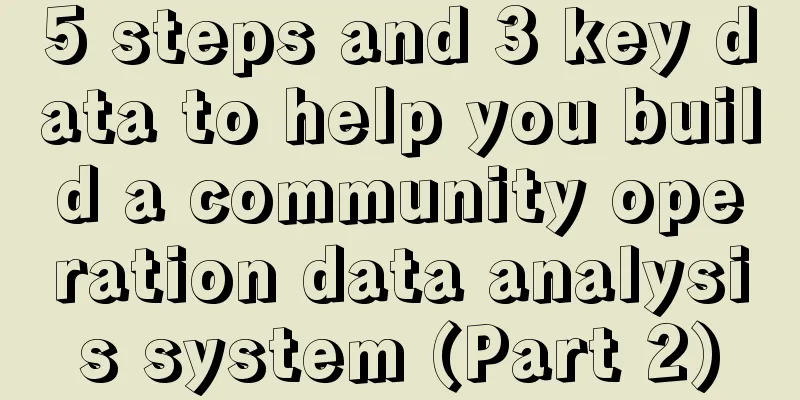5 steps and 3 key data to help you build a community operation data analysis system (Part 2)

Today we continue to talk about community operation data analysis. In the previous article, we said that the key to community operation data analysis is to build a data analysis system suitable for your own community. It can be roughly divided into five steps: designing user path maps, sorting out key data indicators, data access, building a data analysis framework, and decision support. In the previous article, we talked about how to design a user path map and how to sort out key data indicators at key nodes based on this path map. Today, let’s talk about the remaining three links of the community operation data system. 1. Step 3: Data AccessAfter we have designed the user journey map and sorted out the key data indicators, we need to determine how to obtain this data, that is, data access . This step is actually quite simple. It is to determine whether your data statistics work is done manually or using third-party tools, such as Weiban Assistant. In general, it is better to use tools, which will make the entire operation easier. Moreover, current tools can basically meet the real-time monitoring of all paths of community operations, and the data can also be exported to their own databases, whether it is basic data or conversion data, even user behavior analysis, heat maps, etc. These can also be satisfied. The so-called data analysis, first of all, you have to have data, right! Well, at this point, we already have all the data from community operations, and we have classified the data according to the user path map and key nodes. The next step is to enter the analysis stage. That is, we need to build an analysis framework. 2. Step 4: Build a data analysis frameworkWhy should we build an analysis framework first instead of analyzing the data directly? Because there are too many methods for data analysis. For a certain data, you may often draw different conclusions if you use different data analysis methods to analyze it. Moreover, as the scale of the community continues to expand, the data in the database will reach a relatively large scale in terms of type and quantity. At this time, we must learn to find key data from these massive data, analyze it, and get the data related to our initial operating indicators. Therefore, you don’t necessarily have to master all the data analysis methods. You only need to grasp the most important ones and know which link to use which analysis method. The benefits of building an analysis framework are that it can improve our work efficiency on the one hand, and it can help us develop a good habit of data analysis on the other. So how should the specific analysis framework be built? First, let’s still use the user path map. We continue to use the case mentioned in the previous article. The entire user path can be roughly divided into five key nodes: advertising exposure, official account, customer service WeChat, community, and paid ordering. For this path, we can choose to use the funnel analysis method to analyze the entire user path. 1. Method 1: Funnel analysis methodIt is a set of process-based data analysis, which can scientifically reflect the user behavior status and is an important analysis method for the conversion rate at each stage from the starting point to the end point. From the time a user first sees our advertising content to the time they finally pay for an order, during this entire process, we will know the user's conversion rate at each key node. This will let us know which step has a low user conversion rate, so that we can make adjustments to this link. 2. Method 2: Churn Analysis MethodThe corresponding method to the funnel analysis is user churn analysis. Through this method, we can locate which type of users are lost, at which stage they are lost, and further analyze why they are lost. The above two methods are generally an analysis of the entire community operation, from traffic generation to the final paid order, and even the subsequent sharing process. We can also adopt different analysis methods for different operation links. 3. Method 3: Channel AnalysisFor example, we can use channel analysis to analyze the exposure of advertisements in the traffic generation process. And we can use key behavior analysis to analyze the activeness of the community. Of course, with this method, you must first define what kind of behavior is a key behavior, such as replying to keywords in the background of the official account, participating in community topics, checking in at events, etc. 4. Method 4: ROI predictionThe most important thing in the paid ordering phase is to make ROI predictions . To put it bluntly, you need to know how much marketing budget you plan to spend on operating this community, how much sales you plan to achieve, and what the overall input-output ratio is. This will also help us to reasonably price our community products, including paid communities. Of course, for some communities, companies operate communities not to increase sales, but to improve customer service quality. This may also include brand premium. So the key to ROI prediction is to see how you positioned the community at the beginning. I won’t go into details here. 5. Method 5: User stratificationFinally, in the sharing session, I usually like to stratify users and measure their loyalty and satisfaction through the four-quadrant rule. In fact, the analysis method for this part is not necessarily in the sharing stage. For some growing communities, this method can also be used to analyze users regularly. This method may not be like the previous methods. I believe most students are familiar with it, so I will not discuss it in detail. As for the measurement of user loyalty and satisfaction, you may not know much about it, so I will briefly talk about it. When we operate a community, we need to stratify users, including adding customer service WeChat first and then having customer service pull them into the group. In fact, the purpose is to label users so as to distinguish the proportion of different types of users. In this way, we can design different community content and activities to better meet user needs. Then we can use the four-quadrant rule to analyze. First, we can divide users into four types according to the strength of satisfaction and loyalty: as shown in the figure below. The horizontal axis represents satisfaction, the further to the right, the higher the satisfaction; the vertical axis represents user loyalty, the higher the level, the more loyal. In this way, users are divided into four types: loyal users, demand users, freeloaders and low demand users. (Of course, you can customize the label names) However, the user differentiation criteria need to be defined in advance. for example: 1. Loyal users (high satisfaction, high loyalty): They repurchase every month and have successfully recommended friends to purchase more than once. 2. Woven-type users (low satisfaction, high loyalty): They will buy because of the affordable price, and will not make product-related recommendations. The average customer unit price is less than xx yuan 3. Demand-based users (high satisfaction, low loyalty): strong demand for products, low brand loyalty, no repurchase within 3 months 4. Low-demand users (low satisfaction, low loyalty): users who only purchase once or have never purchased We can fill in all this information in a table, and then differentiate the users, and then adopt different operation strategies in a targeted manner. For example, for the users who like to buy products at a discount, we can generally promote sales through package discounts, increase the average order value, or invite friends to bargain, so as to increase the traffic of the activity; and for the communities with many loyal users, we can recommend some high-average-order products and provide more thoughtful services. And so on. Well, the above is the analysis framework built for different links based on the user path map. The data analysis methods in it are all quite practical. In fact, I believe that most people have a clear understanding of the data analysis work of community operation, and the whole idea must be clear. Know what to do, what data to master, and what data analysis methods should be used in different links. However, the reason why we need to do data analysis is not for analysis. All data analysis is ultimately to serve our community operation goals. Therefore, the last step in building a data analysis system is to complete decision support. Step 3: Decision supportThe so-called decision support can actually be roughly divided into three parts: operational strategy formulation, contribution evaluation, and finding growth points. The ultimate goal of all our data analysis is to obtain feedback and help solve the above problems. 1. First, the formulation of operational strategiesThrough various data analyses, we need to know what problems we have in the operation process, such as whether our topics can effectively increase user participation, whether the content output can satisfy users, whether the community activities can stimulate user desire, etc. Then we conduct AB testing and finally formulate and settle on the appropriate operation strategy. In this way, we can directly apply it when we expand the scale of operation. 2. The second step is to evaluate the contributionIt is mainly for operators. Through the analysis of data indicators in various links, such as community quality scoring, activity effect evaluation, operation method scoring, transaction amount within the community, etc., weights are calculated in multiple dimensions, and finally a comprehensive score is calculated to rate the operator. I have come into contact with many companies. When they are doing community operations, their performance appraisal of operators is relatively simple and crude, that is, using the final transaction amount as the content of the operation assessment. But we all know that operation is actually a systematic project. The importance and complexity of the process are often more important than the results. If this point is ignored, not only will the community operation fail to expand, but the community operators themselves will not be able to get satisfaction from their work, let alone the improvement of their capabilities. 3. Finally, find the growth pointThis part is the most important for some community operations that have already reached a certain scale. Especially when traffic operation enters the era of retention operation, how to find new growth points, including user growth and performance growth, from the existing operation model is the most important and critical. In addition, making reasonable use of the community operation data analysis system we have built, applying various analysis methods in the framework, and finding business breakthroughs is also the most important challenge for enterprises and operation teams. IV. ConclusionOK, that’s all about the data analysis of community operations. Let’s summarize it in the end: The most important part of data analysis for community operations is to build your own data analysis system. The specific construction process can be roughly divided into five steps, namely designing user path maps, sorting out key nodes and key data indicators on nodes, data access, building an analysis framework, and finally decision support. The design of the user path can be determined based on actual operations, or it can be determined based on the community operation model discussed in the previous course, such as dividing the entire operation process into three stages: user flow, community activity, and paid conversion. Some key nodes can be sorted out in each stage. At the same time, some core data indicators can be listed one by one at the key nodes according to the three types of basic data, conversion data and user behavior. Next, we need to prepare the corresponding operation tools in advance to complete the data access. In this way, we can conduct targeted analysis on the data based on the acquired data and the established analysis framework. We present the entire data analysis system in one picture, like this! This is more about explaining the data analysis work of community operation from the perspective of thinking. As for some specific details involved, they still need to be adjusted in combination with our initial community positioning and actual operation strategies. When we talk about community operation, it belongs to the category of user operation, and it is the place closest to users. Moreover, operation itself is not a position that is judged solely by results. Therefore, it is even more necessary for us operators to master modular tools, equip ourselves, improve our professionalism through data, and make each decision better through more reasonable auxiliary judgments, making the whole process clearer and more visible. Of course, due to time constraints, I did not discuss some of the specific analysis methods involved, such as channel analysis, funnel analysis, etc. in detail. But the purpose of writing this article is to help everyone establish community operation data analysis and the overall framework building ideas. It may not be so practical, but it is a kind of underlying logic. It is more like a work guide to help us do our work better. Author: Pai Ye Operation |
<<: If a startup brand wants to do well, “brand personality” is absolutely essential!
Recommend
10 essential models for Xiaohongshu in 2023
The latest data shows that Xiaohongshu currently h...
Which cross-border e-commerce platform is suitable for beginners? What are the operating models of cross-border e-commerce platforms?
Cross-border e-commerce is developing very well no...
Amateur fans increased by 40,000, and the "explosive reform" gameplay became the traffic code of Xiaohongshu
The topic of "renovation and listening to adv...
If you copy the benchmark account well, you will make money.
When it comes to learning from benchmarking accoun...
After reviewing Xiaohongshu’s first brand list, we found that this is how to cooperate with buyers to make money
In this era of information explosion, disappearing...
Why do emotional pain points create cultural hits?
This article analyzes the rise and fall of the Chi...
How does Shopee convert click-through rate? What is the normal conversion rate of Shopee?
If the click-through rate of Shopee is not high, i...
Contemporary workers are forced to suffer from "word-pleasing syndrome"
Do you like to add modal particles at the end of s...
The smaller the budget, the more important it is to position correctly
When it comes to "positioning", people o...
WeChat Stores will reshape the future of WeChat e-commerce
The launch of WeChat Stores heralds a major shift ...
Amazon announces the latest delivery time for Black Friday and Christmas
Amazon's US and European sites have announced ...
How are Amazon star scores calculated? How are they calculated?
The principle of Amazon star rating is to add up t...
Where is the entrance to Lazada's customer service? Lazada customer service contact information
With the rapid development of e-commerce, more and...
What do sp ads and sd ads mean? What are the characteristics of sp ads?
Whether you are doing cross-border e-commerce, dom...
“Subject Three” has gone viral, why is Haidilao always able to take advantage of the traffic?
Recently, Haidilao has become popular again with i...









